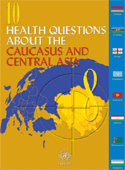10 health questions about the Caucasus and central Asia

Download
By Elke Jakubowski and Albena Arnaudova
2009, xi + 181 pages
ISBN 978 92 890 4169 0
CHF 40.00
In developing countries: CHF 28.00
Order no. 13402057
This book highlights the essentials of health and health systems in Armenia, Azerbaijan, Georgia, Kazakhstan, Kyrgyzstan, Tajikistan, Turkmenistan and Uzbekistan. It then compares these national data with the average data for three groups – their own, the 15 countries that were members of the European Union (EU) before 1 May 2004 and the 27 current EU Member States.
Each chapter provides a concise overview of key health indicators in 1 of the 8 countries, summarizes the key features of the country's health system and describes the results of over a decade of health system reform.
This popular series offers a quick and easy way to grasp the health essentials in a visually attractive format. Comparisons are a compelling source of information that policy-makers and stakeholders, both within countries and internationally, can use to take action against health disparities and alleviate the striking differences in health status among citizens across the WHO European Region.
Such comparisons of groups of countries in the EU context proved to be both interesting and relevant in the previous two books in this series – "10 health questions about the 10" (2004) and "10 health questions about the new EU neighbours" (2006) – as demonstrated by their wide readership.
2009, xi + 181 pages
ISBN 978 92 890 4169 0
CHF 40.00
In developing countries: CHF 28.00
Order no. 13402057
This book highlights the essentials of health and health systems in Armenia, Azerbaijan, Georgia, Kazakhstan, Kyrgyzstan, Tajikistan, Turkmenistan and Uzbekistan. It then compares these national data with the average data for three groups – their own, the 15 countries that were members of the European Union (EU) before 1 May 2004 and the 27 current EU Member States.
Each chapter provides a concise overview of key health indicators in 1 of the 8 countries, summarizes the key features of the country's health system and describes the results of over a decade of health system reform.
This popular series offers a quick and easy way to grasp the health essentials in a visually attractive format. Comparisons are a compelling source of information that policy-makers and stakeholders, both within countries and internationally, can use to take action against health disparities and alleviate the striking differences in health status among citizens across the WHO European Region.
Such comparisons of groups of countries in the EU context proved to be both interesting and relevant in the previous two books in this series – "10 health questions about the 10" (2004) and "10 health questions about the new EU neighbours" (2006) – as demonstrated by their wide readership.



